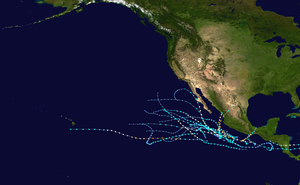| Timeline of the 2022 Pacific hurricane season | |||||
|---|---|---|---|---|---|
 Season summary map | |||||
| Season boundaries | |||||
| First system formed | May 28, 2022 | ||||
| Last system dissipated | October 23, 2022 | ||||
| Strongest system | |||||
| Name | Darby | ||||
| Maximum winds | 140 mph (220 km/h) (1-minute sustained) | ||||
| Lowest pressure | 953 mbar (hPa; 28.14 inHg) | ||||
| Longest lasting system | |||||
| Name | Celia | ||||
| Duration | 12 days | ||||
| |||||
The 2022 Pacific hurricane season was a fairly active tropical cyclone season, with 19 named storm altogether. Ten of those became hurricanes, and four further intensified into major hurricanes (category 3 or higher on the 5-level Saffir–Simpson wind speed scale). Two of this season's storms, Bonnie and Julia, survived the overland crossover from the Atlantic.[1] The season officially started on May 15 in the eastern Pacific—east of 140°W—and June 1 in the central Pacific—between the International Date Line and 140°W, and ended in both regions on November 30. These dates conventionally delimit the period of each year when most tropical cyclones form in the eastern Pacific basin.[2] The season's first storm, Agatha, formed on May 28, and last, Roslyn, dissipated on October 23. Rosyln made landfall in Nayarit with 120 mph (195 km/h) winds, making it the strongest landfalling Pacific hurricane since Patricia in 2015.[3] The season's first major hurricane, Bonnie, entered into the basin from the Atlantic basin on July 2, after crossing Nicaragua as a tropical storm, becoming the first storm to survive the crossover from the Atlantic to the Pacific since Otto in 2016.[4] Three months later, Julia became the second to do so.[5]
This timeline documents tropical cyclone formations, strengthening, weakening, landfalls, extratropical transitions, and dissipations during the season. It includes information that was not released throughout the season, meaning that data from post-storm reviews by the National Hurricane Center, such as a storm that was not initially warned upon, has been included.
By convention, meteorologists use one time zone when issuing forecasts and making observations: Coordinated Universal Time (UTC), and also use the 24-hour clock (where 00:00 = midnight UTC).[6] Tropical cyclone advisories in the Eastern North Pacific basin use both UTC and the nautical time zone where the center of the tropical cyclone is currently located. Time zones utilized (east to west) are: Central, Mountain, Pacific and Hawaii. In this timeline, all information is listed by UTC first, with the respective regional time zone included in parentheses. Additionally, figures for maximum sustained winds and position estimates are rounded to the nearest 5 units (knots, miles, or kilometers), following National Hurricane Center practice. Direct wind observations are rounded to the nearest whole number. Atmospheric pressures are listed to the nearest millibar and nearest hundredth of an inch of mercury.
- ^ Monthly Tropical Weather Summary for November 2022 (Report). Miami, Florida: National Hurricane Center. December 1, 2022. Retrieved December 2, 2022.
- ^ "Hurricane Season Information". Frequently Asked Questions About Hurricanes. Miami, Florida: NOAA Atlantic Oceanographic and Meteorological Laboratory. June 1, 2018. Retrieved April 13, 2021.
- ^ Masters, Jeff (October 22, 2022). "Category 4 Hurricane Roslyn heads for landfall on Mexico's Pacific coast". New Haven, Connecticut: Yale Climate Connections. Retrieved October 25, 2022.
- ^ Masters, Jeff; Henson, Bob (July 2, 2022). "Tropical Storm Colin forms along the South Carolina coast". New Haven Connecticut: Yale Climate Connections. Retrieved July 5, 2022.
- ^ Henson, Bob (October 10, 2022). "As Julia fades, floods plague Central America". New Haven, Connecticut: Yale Climate Connections. Retrieved March 21, 2023.
- ^ "Understanding the Date/Time Stamps". Miami, Florida: National Hurricane Center. Retrieved July 20, 2022.
